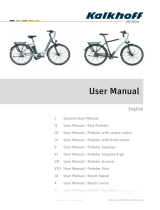Page is loading ...

3
. . . . . . . . . . . . . . . . . . . . . . . . . . . . . . . . . . . . . . . . .
de
Sicherheitshinweise .....................Seite 4
en
Safety Notes ..........................Page 7
fr
Avertissements de sécurité ...............Page 10
it
Norme di sicurezza ....................Pagina 13
nl
Veiligheidsvoorschriften. . . . . . . . . . . . . . . . .Pagina 16
da
Sikkerhedsinstrukser .................... Side 25
sv
Säkerhetsanvisningar .................... Sida 19
no
Sikkerhetsinformasjon ................... Side 28
fi
Turvallisuusohjeita ...................... Sivu 22
tr
Güvenlik Talimatı .......................Sayfa 37
pl
Wskazówki bezpieczeństwa ..............Strona 40
ru
Указания по безопасности ...........Страница 44
fa
es
Instrucciones de seguridad ..............Página 31
pt
Indicações de segurança ................Página 34
51

7
en
Safety Warnings for Lithium-Ion Batteries
Read all safety warnings and all instructions. Failure to follow the warn-
ings and instructions may result in electric shock, fire and/or serious injury.
Save all safety warnings and all instructions for
future reference.
t These safety warnings apply only for Bosch Roxxter lithium-ion batteries!
t Do not open the battery. Danger of short-circuiting.
Protect the battery against heat, e. g., against continuous intense sunlight, fire,
water, and moisture. Danger of explosion.
t In case of damage and improper use of the battery, vapours may be emitted. Ventilate
the area and seek medical help in case of complaints. The vapours can irritate the
respiratory system.
t Use the battery only together with your Bosch Roxxter product. This is the only way to
protect the battery against dangerous overload.
t Recharge only with the charger specified by the manufacturer. A charger that is suitable
for one type of battery pack may create a risk of fire when used with another battery pack.
t Only charge the battery when fitted in the appliance.
t Only use the battery supplied with the robot vacuum cleaner. Using other batteries may
result in injury or fire.
t When battery pack is not in use, keep it away from other metal objects like paper clips,
coins, keys, nails, screws, or other small metal objects that can make a connection
from one terminal to another. Shorting the battery terminals together may cause burns or
a fire.
t If the battery becomes defective, liquid can escape and come into contact with
adjacent components. Check any parts concerned. Clean such parts or replace them, if
required.

8
t Under abusive conditions, liquid may be ejected from the battery; avoid contact. If
contact accidentally occurs, flush with water. If liquid contacts eyes, additionally seek
medical help. Liquid ejected from the battery may cause irritations or burns.
t Do not use defective batteries. Replace defective batteries and dispose of them.
t The battery can be damaged by pointed objects such as nails or screwdrivers or by
force applied externally. An internal short circuit can occur and the battery can burn,
smoke, explode or overheat.
Operation
Recommendations for Optimal Handling of the Battery
Note: The battery supplied is partially charged. To ensure full capacity of the battery, com-
pletely charge the battery in the battery charger before using your power tool for the first time.
The lithium-ion battery can be charged at any time without reducing its service life. Interrupt-
ing the charging procedure does not damage the battery.
The lithium-ion battery is protected against deep discharging by the “Electronic Cell Protec-
tion (ECP)”. When the battery is empty, the machine is switched off by means of a protective
circuit: The inserted tool no longer rotates.
The battery must be charged before putting the robot vacuum cleaner into storage for a long
time.
If the robot vacuum cleaner will be in storage for several months, charge the battery fully and
remove it from the appliance.
t Do not continue to press the On/Off switch after the machine has been automatically
switched off. The battery must be charged in the appliance first.
The battery is equipped with a NTC temperature control which allows charging only within a
temperature range of between 5 °C and 50 °C. A long battery service life is achieved in this
manner.
Store the battery only within a temperature range between –20 °C and 60 °C. As an example,
do not leave the battery in the car in summer.
A significantly reduced working period after charging indicates that the battery is used and
must be replaced.
Observe the notes for disposal.
en

9
Maintenance and Service
Transport
The contained lithium-ion batteries are subject to the Dangerous Goods Legislation require-
ments. The user can transport the batteries by road without further requirements.
When being transported by third parties (e.g.: air transport or forwarding agency), special
requirements on packaging and labelling must be observed. For preparation of the item being
shipped, consulting an expert for hazardous material is required.
Dispatch batteries only when the housing is undamaged. Tape or mask off open contacts and
pack up the battery in such a manner that it cannot move around in the packaging.
Please also observe possibly more detailed national regulations.
Disposal
The machine, rechargeable batteries, accessories and packaging should be sorted for
environmental- friendly recycling.
Do not dispose of power tools and batteries/rechargeable batteries into household waste!
Only for EC countries:
According to the European Guideline 2012/19/EU, power tools that are
no longer usable, and according to the European Guideline 2006/66/EC,
defective or used battery packs/batteries, must be collected separately and
disposed of in an environmentally correct manner.
Battery packs/batteries:
Li-Ion:
Please observe the instructions in section “Transport”.
Subject to change without notice.
en

56
Bosch Home Appliance Group
P.O. Box 83 01 01
D-81701 Munich
Germany
www.bosch-home.com
8001129803 980809
/

